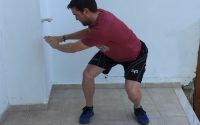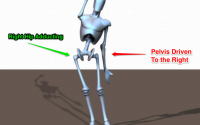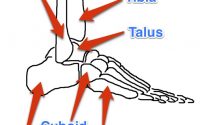Bones Move
When you are looking at the analysis of any movement pattern, the common starting point of looking at what the joints are doing that’s where I used to start. However, if you want to get a deeper understanding of movement you need to take a few steps back. Here are the steps I see as being important…
Lets assume we are trying to analyse the movement at a right knee:
- What is driving the movement
- Is the driving force coming from above or below the knee
- What are the proximal and distal bones doing in all 3 planes
- THEN you can determine what is happening at the joint.
This is a serious step forward in our understanding. There are many reasons this helps us out with assessment and treatment and we will work our way through these in this and the assessment and treatment book.
When you are assessing bone motion, there are 12 directions a bone can move in. There are the 3 cardinal planes; Sagittal, Frontal and Transverse. Within this you also have 2 variations of movement in each plane; Translation and Rotation.
The terminology we use to keep it clear is:
Translation Rotation
Sagittal forward/back anterior tilt/posterior tilt
Frontal left/right left tilt/right tilt
Transverse up/down left rotation/right rotation
The reason we do this is that it makes it clear and distinct from joint movements, because these are bone movements, not joint movements!! Be careful in the transverse plane not to use internal/external rotation for bone movements…because it confuses things with joint motions and can make life difficult when changing from analysing the left and right leg, for example.
Translation
Translation is linear movement, so the bone (in this case) will move along one of its’ axis. For example, lets say the tibia is going to move forwards in the sagittal plane. If the starting position of the femur is vertical it will move forwards in the sagittal plane, but at the end of the movement it will still be vertical. This translation can occur in all 3 planes all the time with every movement. In the sagittal plane the femur could move forward or back. In the frontal plane it would move left or right and along the transverse axis it can move up and down.
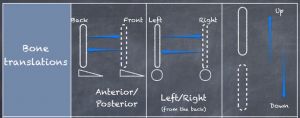
Rotation
Rotation is movement around an axis. As a result the bone will change its’ orientation in space. Lets use the tibia again starting vertically. If the tibia rotates anteriorly around an axis in the mid-shaft the tibial plateau will move forward, and the ankle will move backwards. The point of the axis in the mid shaft will not have moved forward or back, but the tibia will simply have rotated anteriorly.
Again, there are two directions of movement in each plane, sagittal will be anterior and posterior rotation. Frontal will be left and right tilt and in the transverse plane you have left and right rotation.
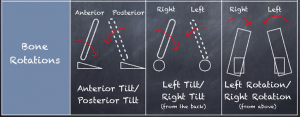
Summary
For bones moving…it’s as simple as that. We believe that in functional movement the bones will move in all 3 planes in both translation and rotation. This means that what you see in your patients is not movement in one plane, but a combination of 6 movements (3 translations and 3 rotations), which combine to bring you the movement you see.
When thought of like this it is easy to see how it gets a little complicated at first, however, once mastered, it makes movement so much easier to understand. Obviously, we have only gone through a simple example of the tibia in one plane, but hopefully you can see how it can be applied to all bones in all planes.
The next step is to work out what a joint is feeling. This means you have to first determine what the proximal bone and the distal bone of that joint is doing in all 3 planes. Only then can you try and understand what the joint is feeling. If you want to have a go at a practical example, try work out what the femur is doing in all 3 planes in translation and rotation during the front leg in gait. Feel free to get in touch with your answers and I can send you the answer I have come up with.
Physioblogger
